The Lord of the Rings: The Two Towers (2002)
CAST: Elijah Wood, Ian McKellen, Viggo Mortensen, Liv Tyler, Sean Astin, John Rhys-Davies, Bernard Hill, Christopher Lee, Billy Boyd, Dominic Monaghan, Orlando Bloom, Miranda Otto, David Wenham, Karl Urban, Brad Dourif, Hugo Weaving, Cate Blanchett, Andy Serkis
REVIEW:
New Zealand director Peter Jackson and New Line Cinema took a big risk with 2001’s The Fellowship of the Ring, the first installment of their colossal film adaptation of J.R.R. Tolkien’s trilogy The Lord of the Rings. Fortunately, not only did The Fellowship of the Ring pay off, it went on to become one of the biggest box office smashes in recent history and one of the most acclaimed motion pictures of the year, winning four Academy Awards (though not the coveted Best Picture) and setting a new standard for epic fantasy adventure. But therein lay a new danger. With the first film being deservedly acclaimed, what if the second didn’t live up to the now high expectations? The first installment was one of the great films of 2001 or any other year, but even the most enthusiastic viewers had room for some doubt. This would not be the first time a solid film was followed by an inferior sequel. The Two Towers would also have the unenviable position of providing the middle act, advancing events from the first movie while leading into the third, incomplete on its own. Fortunately, if it’s not quite as flawless a film as The Fellowship of the Ring, The Two Towers is no slouch, continuing to paint on an epic, immersive, and enthralling canvas, and builds to one of the most tremendous battle scenes yet committed to film.
We pick up right where we left off at the end of The Fellowship of the Ring. Frodo (Elijah Wood) and Sam (Sean Astin), now separated from the rest of the Fellowship, are continuing their trek toward Mordor, while Aragorn (Viggo Mortensen), Legolas (Orlando Bloom), and Gimli (John Rhys-Davies) are pursuing the Uruk-hai who have captured Merry (Dominic Monaghan) and Pippin (Billy Boyd). Frodo’s journey is growing more difficult now that he and Sam are on their own, with the young Hobbit beginning to feel the burden of the ring he bears. And the two Hobbits are not alone. They are being trailed by the twisted creature Gollum (Andy Serkis), the ring’s longest previous owner, obsessed with being reunited with his “precious”. And the evil wizard Saruman (Christopher Lee), who cast his lot in with Sauron in the first film, is raising an army to mount a massive assault on the human kingdom of Rohan.
 Tolkien purists may grumble about the changes from page to screen—The Two Towers deviates from the source material in more significant ways than its predecessor—though it’s hard to criticize any of them onscreen. The Battle of Helm’s Deep, which occupied only a few pages in Tolkien’s book, has been expanded into a thirty-minute battle royale; it is the high point and the climax of the film, with everything else leading inexorably to it. It’s one of the most tremendous battles ever committed to film, but Jackson deftly keeps the focus on the principal characters, never allowing things to slip into incoherent chaos. Jackson also injects a little humor, such as Legolas and Gimli trying to outdo each other with kill counts during the Battle of Helm’s Deep, and something of a budding love triangle between Aragorn, Arwen (Liv Tyler), and Eowyn (Miranda Otto), though neither the humor nor romance takes up a great deal of screentime. The kingdom of Rohan is a striking new location, modeled after medieval Europe, and the new cast of characters it introduces are welcome additions.
Tolkien purists may grumble about the changes from page to screen—The Two Towers deviates from the source material in more significant ways than its predecessor—though it’s hard to criticize any of them onscreen. The Battle of Helm’s Deep, which occupied only a few pages in Tolkien’s book, has been expanded into a thirty-minute battle royale; it is the high point and the climax of the film, with everything else leading inexorably to it. It’s one of the most tremendous battles ever committed to film, but Jackson deftly keeps the focus on the principal characters, never allowing things to slip into incoherent chaos. Jackson also injects a little humor, such as Legolas and Gimli trying to outdo each other with kill counts during the Battle of Helm’s Deep, and something of a budding love triangle between Aragorn, Arwen (Liv Tyler), and Eowyn (Miranda Otto), though neither the humor nor romance takes up a great deal of screentime. The kingdom of Rohan is a striking new location, modeled after medieval Europe, and the new cast of characters it introduces are welcome additions.
It’s hard to deny, however, that The Two Towers suffers somewhat from the “middle act” syndrome, and as majestic, sweeping, and often riveting a motion picture as this is, it is not quite up to the level of The Fellowship of the Ring (though it comes close). Even with the fascinating Gollum, Sam and Frodo traipsing through swamps and marshes en route to Mordor gets a little tedious, as does Merry and Pippin’s time with the Ents, walking talking trees led by the philosophical Treebeard (voiced by John Rhys-Davies). Narratively, the Hobbits take a backseat to the humans this time around.
 This second installment gives the principal cast a chance to evolve in their roles. Elijah Wood is an increasingly troubled and weary Frodo, slipping under the influence of the ring and becoming more dependent on Sean Astin’s faithful Sam, although being separated from the rest of the Fellowship and having to carry more of his own disconnected storyline sometimes makes some of Wood’s acting weaknesses and lack of screen presence more obvious in a way it wasn’t in the first installment. Viggo Mortensen has stronger screen presence and mostly takes over the mantle of the movie’s real “star” here, as Aragorn steps up as more of a leader. Ian McKellen plays Gandalf with greater power and authority now that he has become Gandalf the White, contrasted by Christopher Lee’s sinister, baleful Saruman. Billy Boyd and Dominic Monaghan get their own little subplot this time around, but John Rhys-Davies is mostly around for comic relief and Orlando Bloom still doesn’t have much to do besides action scenes. Hugo Weaving and Cate Blanchett have cameos. Of the newcomers, Miranda Otto creates a strong female character who would rather face danger side-by-side with the men than wait at home for their return, Bernard Hill brings dignity and pride to the noble but by no means infallible King Theoden, Brad Dourif is suitably slimy as the unsubtly named Wormtongue, and David Wenham is the morally ambiguous Faramir. If there’s a marginal “weak link” besides Elijah Wood, it’s Karl Urban, whose Eomer is not especially memorable. The most striking is Gollum (only glimpsed fleetingly in The Fellowship of the Ring), a computer-generated creature whose voice and body language is supplied by actor Andy Serkis through the revolutionary motion capture technique (Serkis physically performed all of Gollum’s scenes alongside the other actors, then was digitally replaced with Gollum in post-production, with his movements and facial expressions providing the basis for the animation). Not only is Gollum quite possibly the most realistic CGI character yet to appear onscreen, but he’s also the most complex character in the movie, tortured, scheming, conflicted, seemingly even schizophrenic, and above all obsessed with the ring. The range and depth of the emotions Gollum projects is remarkable, and Serkis’ performance inspires equal parts pity and revulsion.
This second installment gives the principal cast a chance to evolve in their roles. Elijah Wood is an increasingly troubled and weary Frodo, slipping under the influence of the ring and becoming more dependent on Sean Astin’s faithful Sam, although being separated from the rest of the Fellowship and having to carry more of his own disconnected storyline sometimes makes some of Wood’s acting weaknesses and lack of screen presence more obvious in a way it wasn’t in the first installment. Viggo Mortensen has stronger screen presence and mostly takes over the mantle of the movie’s real “star” here, as Aragorn steps up as more of a leader. Ian McKellen plays Gandalf with greater power and authority now that he has become Gandalf the White, contrasted by Christopher Lee’s sinister, baleful Saruman. Billy Boyd and Dominic Monaghan get their own little subplot this time around, but John Rhys-Davies is mostly around for comic relief and Orlando Bloom still doesn’t have much to do besides action scenes. Hugo Weaving and Cate Blanchett have cameos. Of the newcomers, Miranda Otto creates a strong female character who would rather face danger side-by-side with the men than wait at home for their return, Bernard Hill brings dignity and pride to the noble but by no means infallible King Theoden, Brad Dourif is suitably slimy as the unsubtly named Wormtongue, and David Wenham is the morally ambiguous Faramir. If there’s a marginal “weak link” besides Elijah Wood, it’s Karl Urban, whose Eomer is not especially memorable. The most striking is Gollum (only glimpsed fleetingly in The Fellowship of the Ring), a computer-generated creature whose voice and body language is supplied by actor Andy Serkis through the revolutionary motion capture technique (Serkis physically performed all of Gollum’s scenes alongside the other actors, then was digitally replaced with Gollum in post-production, with his movements and facial expressions providing the basis for the animation). Not only is Gollum quite possibly the most realistic CGI character yet to appear onscreen, but he’s also the most complex character in the movie, tortured, scheming, conflicted, seemingly even schizophrenic, and above all obsessed with the ring. The range and depth of the emotions Gollum projects is remarkable, and Serkis’ performance inspires equal parts pity and revulsion.
The Two Towers starts out a little slowly, but the rousing climax will leave viewers eager for what comes next, a worthy continuation of a series which—barring a disappointing finale—is shaping up to be one of the crowning achievements of cinema, and one of the most majestic and ambitious filmmaking undertakings ever mounted. We may never see its like again, but at least we have one more installment to anticipate.
* * * 1/2
